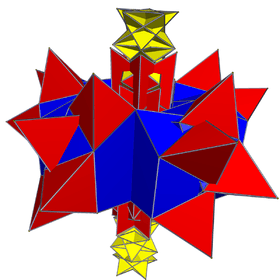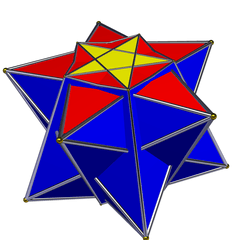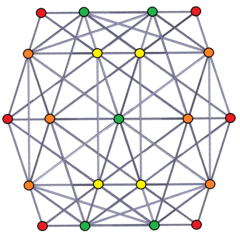Great duoantiprism
| Great duoantiprism | |
|---|---|
| Type | Uniform polychoron |
| Schläfli symbols | s{5}s{5/3} {5}⊗{5/3} h{10}s{5/3} s{5}h{10/3} h{10}h{10/3} |
| Coxeter diagrams | |
| Cells | 50 (3.3.3) 10 (3.3.3.5) 10 (3.3.3.5/3) |
| Faces | 200 {3} 10 {5} 10 {5/2} |
| Edges | 200 |
| Vertices | 50 |
| Vertex figure |  star-gyrobifastigium |
| Symmetry group | [5,2,5]+, order 50 [(5,2)+,10], order 100 [10,2+,10], order 200 |
| Properties | Vertex-uniform |
 Net (overlapping in space) | |
The great duoantiprism is the only uniform star-duoantiprism solution p=5, q=5/3, in 4-dimensional geometry. It has Schläfli symbol {5}⊗{5/3}, s{5}s{5/3} or ht0,1,2,3{5,2,5/3}, Coxeter diagram ![]()
![]()
![]()
![]()
![]()
![]()
![]()
![]()
![]()
Its vertices are a subset of those of the small stellated 120-cell.
Images
 stereographic projection, centered on one pentagrammic crossed-antiprism |
 Orthogonal projection, with vertices colored by overlaps, red, orange, yellow, green have 1, 2, 3,4 multiplicity. |
Other names
References
- ↑ Jonathan Bowers - Miscellaneous Uniform Polychora 965. Gudap
- ↑ http://www.polychora.com/12GudapsMovie.gif Animation of cross sections
- Regular Polytopes, H. S. M. Coxeter, Dover Publications, Inc., 1973, New York, p. 124.
- Norman Johnson Uniform Polytopes, Manuscript (1991)
- N.W. Johnson: The Theory of Uniform Polytopes and Honeycombs, Ph.D. Dissertation, University of Toronto, 1966
- Klitzing, Richard. "4D uniform polytopes (polychora) s5/3s2s5s - gudap".
This article is issued from
Wikipedia.
The text is licensed under Creative Commons - Attribution - Sharealike.
Additional terms may apply for the media files.